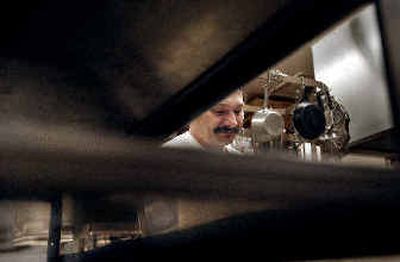Prison spending likely to rise

BOISE – Legislative budget writers Tuesday approved a substantial budget increase and nearly 60 new state employees to cope with an overflow of offenders in state prisons and on probation.
“We keep that fire hose going every year,” a frustrated Sen. Elliot Werk, D-Boise, complained about the state’s prison spending. “At some point, it’s got to stop. I think we need to be changing direction in our state.”
But the $117 million prison budget passed the Joint Finance-Appropriations Committee on a series of lopsided votes, with just three or four of the panel’s minority Democrats objecting each time.
“We’re all experiencing the same frustration,” said Senate Finance Chairman Dean Cameron, R-Rupert. “Unfortunately, someone’s got to set a budget.”
That budget, a 6 percent increase from this year’s general-fund spending level, doesn’t include another $1.5 million for various prison construction projects that lawmakers plan to shift to the Permanent Building Fund, and costs for some salary and payroll expenses that they plan to take up later.
Rep. Shirley Ringo, D-Moscow, voted in favor of the main portion of the budget, though she opposed two companion bills. “Our policies do place these people there to be cared for,” she said.
Idaho’s prison population has more than doubled in the past decade, despite the state’s relatively low crime rates.
“I think we have some policies that expand our problem,” Ringo said, pointing to mandatory minimum sentences and long waits for parole.
However, Senate Judiciary Chairman Denton Darrington, R-Declo, who addressed the joint committee earlier, said, “The reason our prison population is heavy is because people commit crime. … When they are locked up, our citizens are safer, there’s no question.”
Two House bills this year – to speed up inmates’ parole and to reinstate time off for good behavior – have gone nowhere. Gov. Dirk Kempthorne announced in January that he’s naming a new Criminal Justice Commission to examine Idaho’s entire system and recommend changes, in part to reduce the prison population.
Said Ringo, “I’m glad we’re making that move, and I hope it will lead to something.”
Among the new employees approved Tuesday are 30 to staff a new 136-bed housing unit for female prisoners – Idaho’s fastest-growing group – and 14 to monitor the increasing number of offenders on probation and parole.
Those probation and parole positions “are badly needed,” state Corrections Director Tom Beauclair said after the committee’s vote. “We’re expecting about 900 additional offenders in the community each year over the next four years. So I feel good that they’re supporting our needs in a very difficult time.”
Idaho’s prisons are full, and hundreds of prisoners are housed in county jails. Prison officials have had to pitch tents and set up cots to house the overflow of inmates in the past year, and they’ve added beds to shoehorn another 159 prisoners into the state’s main prison south of Boise through double-bunking – despite a court-ordered population cap.
Beauclair went to federal court last week to ask that the cap be lifted, as part of mediation in a long-running court case. “That failed, and yet I’m still optimistic,” he said.
Beauclair said the state has kept the court informed of its moves to double-bunk, and hasn’t been ordered to stop. He’s hopeful that changes in the state’s prison system since the cap first was imposed in 1987, including the opening of the new Idaho Maximum Security Institution, renovations, and construction of a medical unit, eventually will result in the lifting of the population cap.
But if the courts were to order the double-bunking to stop, Idaho would have to ship inmates out of state immediately, Beauclair said. “We’ve already checked – there are beds in Missouri, there are beds in New Mexico. There are a lot of beds around the country.”
Sending inmates out of state is costly and unpopular. But Teresa Jones, spokeswoman for the state Department of Corrections, said a recent notice issued to inmates at the main Idaho State Correctional Institution south of Boise and the nearby Idaho Correctional Center asking for volunteers to head out-of-state drew more than 200 volunteers.
“For some people who have a longer sentence it’s described as a break, the only way they get to travel,” Jones said. “And there is a perception that we’re pretty tough, we require inmates to program, we require respect, and they kind of want a break.”
The budget set by the joint committee on Tuesday, which still needs approval from both houses and the governor’s signature to become law, includes one new initiative that several lawmakers said sounded hopeful. It’s an “Intermediate Sanction and Revocation Facility,” to be housed in existing prison work-center beds, to deal with probation violators.
When courts say it’s appropriate, the violators could be sent to the facility for up to 90 days of intensive programming and treatment, and then released on probation again – rather than being sent straight to prison.
“I think you’re seeing some efforts on our part to be a little bit creative here,” Beauclair said.
Among the $1.5 million in construction projects that lawmakers will take up as part of the Permanent Building Fund budget is a new “sprung structure,” or temporary building, to house an additional 100 inmates.
But Beauclair said even all those measures won’t help beyond the coming year. “Prisons are full, county jails are full,” he said. “This takes care of growth maybe for one year, that’s it.”